radiator PONTIAC VIBE 2003 Owners Manual
[x] Cancel search | Manufacturer: PONTIAC, Model Year: 2003, Model line: VIBE, Model: PONTIAC VIBE 2003Pages: 381, PDF Size: 3.03 MB
Page 223 of 381
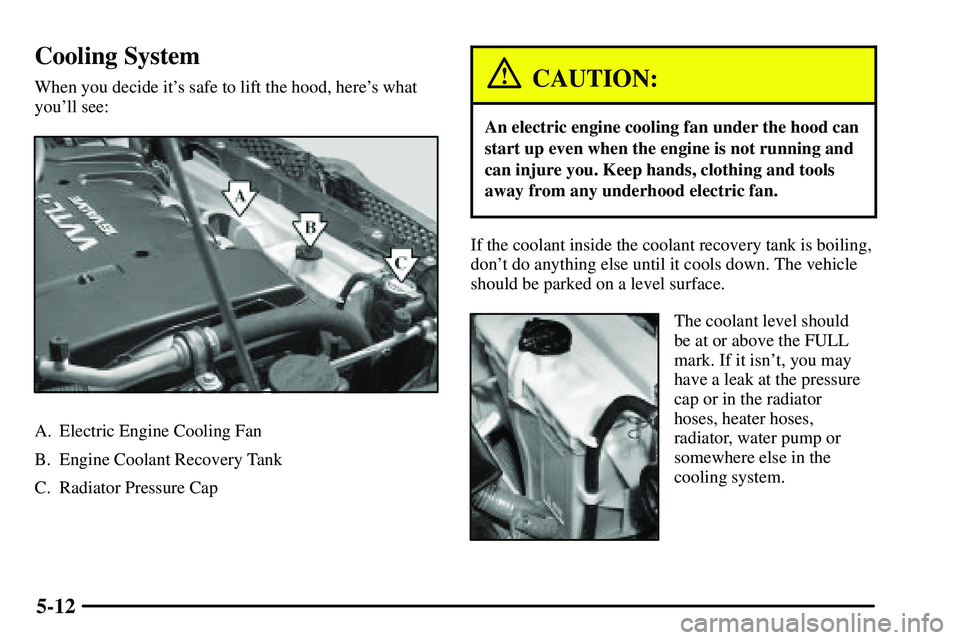
5-12
Cooling System
When you decide it's safe to lift the hood, here's what
you'll see:
A. Electric Engine Cooling Fan
B. Engine Coolant Recovery Tank
C. Radiator Pressure Cap
CAUTION:
An electric engine cooling fan under the hood can
start up even when the engine is not running and
can injure you. Keep hands, clothing and tools
away from any underhood electric fan.
If the coolant inside the coolant recovery tank is boiling,
don't do anything else until it cools down. The vehicle
should be parked on a level surface.
The coolant level should
be at or above the FULL
mark. If it isn't, you may
have a leak at the pressure
cap or in the radiator
hoses, heater hoses,
radiator, water pump or
somewhere else in the
cooling system.
Page 224 of 381

5-13
CAUTION:
Heater and radiator hoses, and other engine
parts, can be very hot. Don't touch them. If you
do, you can be burned.
Don't run the engine if there is a leak. If you run
the engine, it could lose all coolant. That could
cause an engine fire, and you could be burned.
Get any leak fixed before you drive the vehicle.
If there seems to be no leak, with the engine on, check to
see if the electric engine cooling fan is running. If the
engine is overheating, the fan should be running. If it
isn't, your vehicle needs service.
NOTICE:
Engine damage from running your engine
without coolant isn't covered by your warranty.
Page 225 of 381
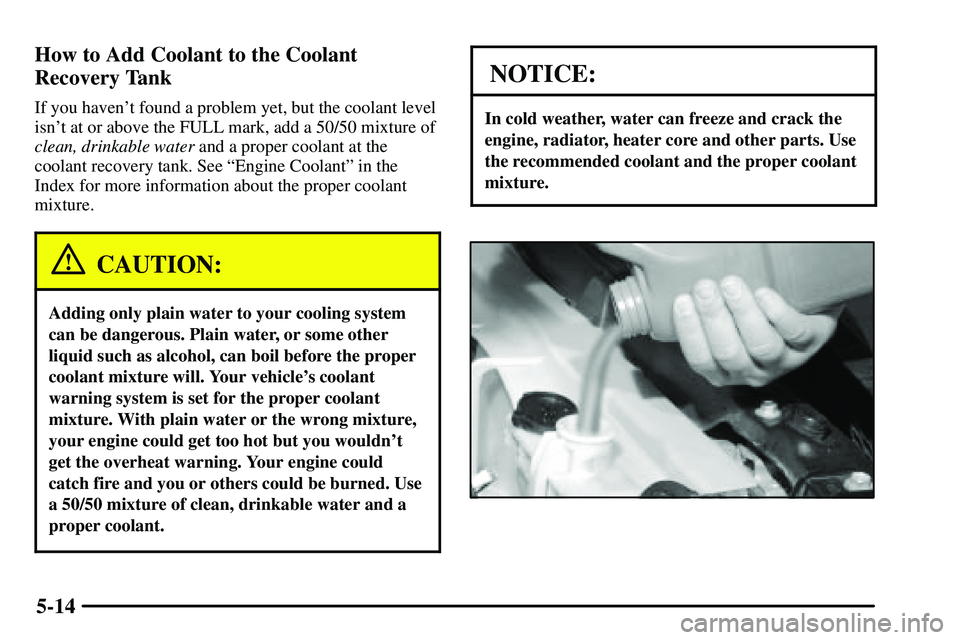
5-14 How to Add Coolant to the Coolant
Recovery Tank
If you haven't found a problem yet, but the coolant level
isn't at or above the FULL mark, add a 50/50 mixture of
clean, drinkable water and a proper coolant at the
coolant recovery tank. See ªEngine Coolantº in the
Index for more information about the proper coolant
mixture.
CAUTION:
Adding only plain water to your cooling system
can be dangerous. Plain water, or some other
liquid such as alcohol, can boil before the proper
coolant mixture will. Your vehicle's coolant
warning system is set for the proper coolant
mixture. With plain water or the wrong mixture,
your engine could get too hot but you wouldn't
get the overheat warning. Your engine could
catch fire and you or others could be burned. Use
a 50/50 mixture of clean, drinkable water and a
proper coolant.
NOTICE:
In cold weather, water can freeze and crack the
engine, radiator, heater core and other parts. Use
the recommended coolant and the proper coolant
mixture.
Page 226 of 381
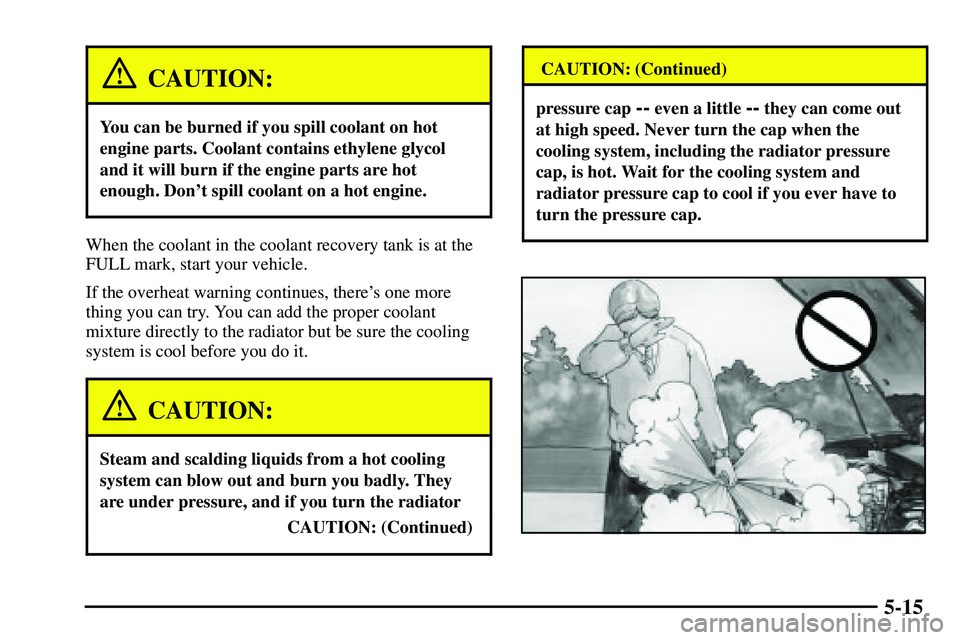
5-15
CAUTION:
You can be burned if you spill coolant on hot
engine parts. Coolant contains ethylene glycol
and it will burn if the engine parts are hot
enough. Don't spill coolant on a hot engine.
When the coolant in the coolant recovery tank is at the
FULL mark, start your vehicle.
If the overheat warning continues, there's one more
thing you can try. You can add the proper coolant
mixture directly to the radiator but be sure the cooling
system is cool before you do it.
CAUTION:
Steam and scalding liquids from a hot cooling
system can blow out and burn you badly. They
are under pressure, and if you turn the radiator
CAUTION: (Continued)
CAUTION: (Continued)
pressure cap -- even a little -- they can come out
at high speed. Never turn the cap when the
cooling system, including the radiator pressure
cap, is hot. Wait for the cooling system and
radiator pressure cap to cool if you ever have to
turn the pressure cap.
Page 227 of 381

5-16 How to Add Coolant to the Radiator
1. You can remove the radiator pressure cap when the
cooling system, including the radiator pressure cap and
upper radiator hose, is no longer hot. Turn the pressure
cap slowly counterclockwise until it first stops. (Don't
press down while turning the pressure cap.)
If you hear a hiss, wait for that to stop. A hiss means
there is still some pressure left.
2. Then keep turning the pressure cap, but now push
down as you turn it. Remove the pressure cap.
3. Fill the radiator with the proper coolant mixture, up
to the base of the filler neck. See ªEngine Coolantº
in the Index for more information about the proper
coolant mixture.
Page 228 of 381
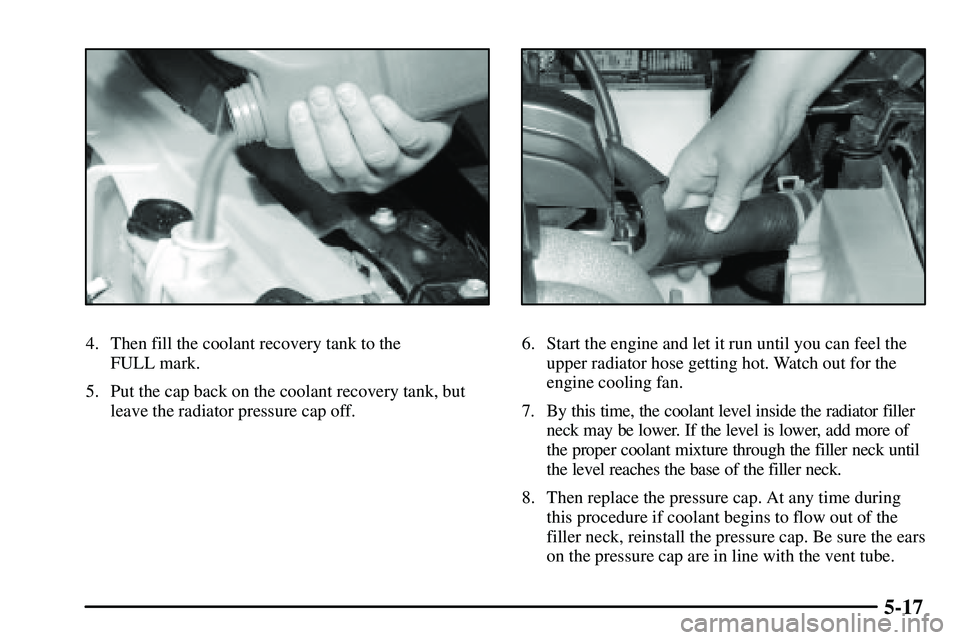
5-17
4. Then fill the coolant recovery tank to the
FULL mark.
5. Put the cap back on the coolant recovery tank, but
leave the radiator pressure cap off.6. Start the engine and let it run until you can feel the
upper radiator hose getting hot. Watch out for the
engine cooling fan.
7. By this time, the coolant level inside the radiator filler
neck may be lower. If the level is lower, add more of
the proper coolant mixture through the filler neck until
the level reaches the base of the filler neck.
8. Then replace the pressure cap. At any time during
this procedure if coolant begins to flow out of the
filler neck, reinstall the pressure cap. Be sure the ears
on the pressure cap are in line with the vent tube.
Page 246 of 381
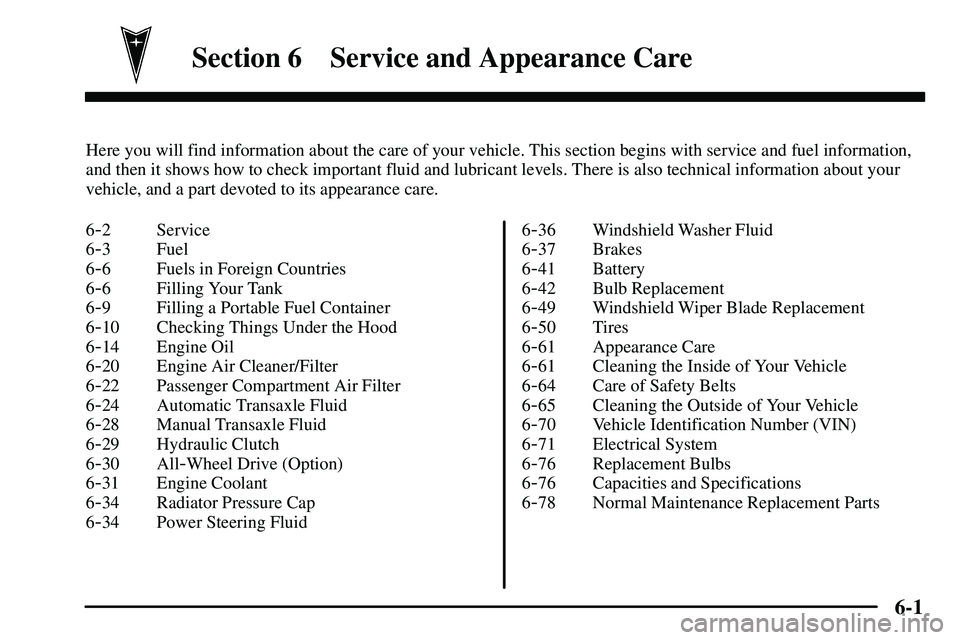
6-
6-1
Section 6 Service and Appearance Care
Here you will find information about the care of your vehicle. This section begins with service and fuel information,
and then it shows how to check important fluid and lubricant levels. There is also technical information about your
vehicle, and a part devoted to its appearance care.
6
-2 Service
6
-3 Fuel
6
-6 Fuels in Foreign Countries
6
-6 Filling Your Tank
6
-9 Filling a Portable Fuel Container
6
-10 Checking Things Under the Hood
6
-14 Engine Oil
6
-20 Engine Air Cleaner/Filter
6
-22 Passenger Compartment Air Filter
6
-24 Automatic Transaxle Fluid
6
-28 Manual Transaxle Fluid
6
-29 Hydraulic Clutch
6
-30 All-Wheel Drive (Option)
6
-31 Engine Coolant
6
-34 Radiator Pressure Cap
6
-34 Power Steering Fluid6
-36 Windshield Washer Fluid
6
-37 Brakes
6
-41 Battery
6
-42 Bulb Replacement
6
-49 Windshield Wiper Blade Replacement
6
-50 Tires
6
-61 Appearance Care
6
-61 Cleaning the Inside of Your Vehicle
6
-64 Care of Safety Belts
6
-65 Cleaning the Outside of Your Vehicle
6
-70 Vehicle Identification Number (VIN)
6
-71 Electrical System
6
-76 Replacement Bulbs
6
-76 Capacities and Specifications
6
-78 Normal Maintenance Replacement Parts
Page 257 of 381
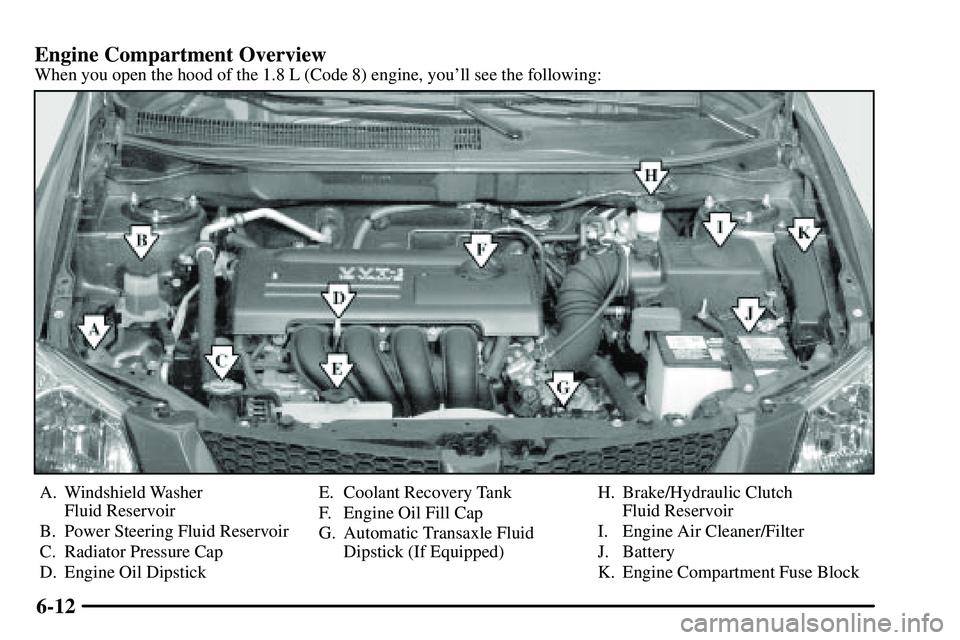
6-12 Engine Compartment Overview
When you open the hood of the 1.8 L (Code 8) engine, you'll see the following:
A. Windshield Washer
Fluid Reservoir
B. Power Steering Fluid Reservoir
C. Radiator Pressure Cap
D. Engine Oil DipstickE. Coolant Recovery Tank
F. Engine Oil Fill Cap
G. Automatic Transaxle Fluid
Dipstick (If Equipped)H. Brake/Hydraulic Clutch
Fluid Reservoir
I. Engine Air Cleaner/Filter
J. Battery
K. Engine Compartment Fuse Block
Page 258 of 381

6-13
When you open the hood of the 1.8 L (Code L) H.O. DOHC engine, you'll see the following:
A. Windshield Washer Fluid
Reservoir
B. Power Steering Fluid Reservoir
C. Radiator Pressure Cap
D. Engine Oil DipstickE. Coolant Recovery Tank
F. Engine Oil Fill Cap
G. Automatic Transaxle Fluid
Dipstick (If Equipped)H. Brake/Hydraulic Clutch Fluid
Reservoir
I. Engine Air Cleaner/Filter
J. Battery
K. Engine Compartment Fuse Block
Page 277 of 381
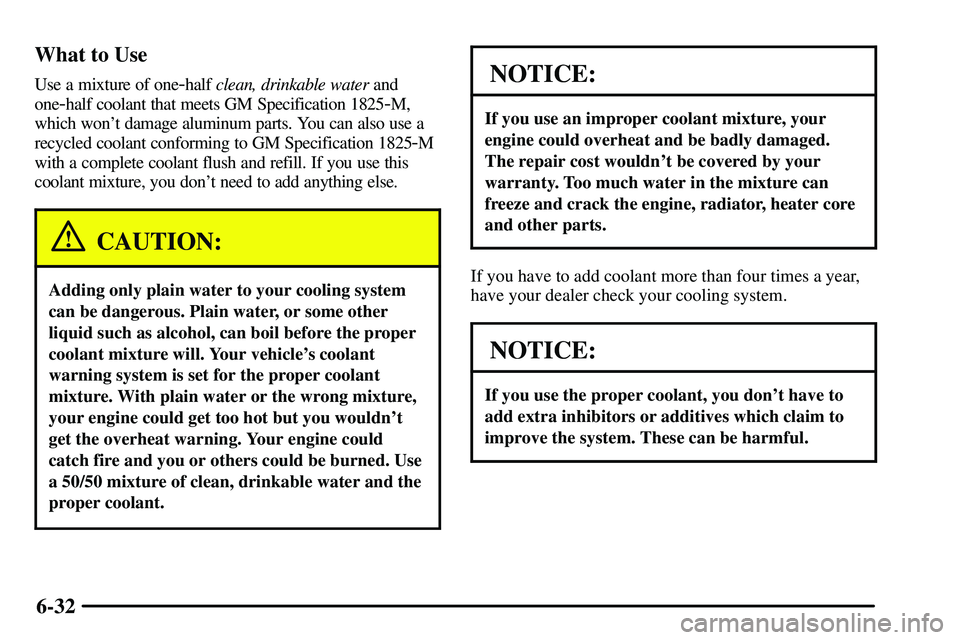
6-32 What to Use
Use a mixture of one-half clean, drinkable water and
one
-half coolant that meets GM Specification 1825-M,
which won't damage aluminum parts. You can also use a
recycled coolant conforming to GM Specification 1825
-M
with a complete coolant flush and refill. If you use this
coolant mixture, you don't need to add anything else.
CAUTION:
Adding only plain water to your cooling system
can be dangerous. Plain water, or some other
liquid such as alcohol, can boil before the proper
coolant mixture will. Your vehicle's coolant
warning system is set for the proper coolant
mixture. With plain water or the wrong mixture,
your engine could get too hot but you wouldn't
get the overheat warning. Your engine could
catch fire and you or others could be burned. Use
a 50/50 mixture of clean, drinkable water and the
proper coolant.
NOTICE:
If you use an improper coolant mixture, your
engine could overheat and be badly damaged.
The repair cost wouldn't be covered by your
warranty. Too much water in the mixture can
freeze and crack the engine, radiator, heater core
and other parts.
If you have to add coolant more than four times a year,
have your dealer check your cooling system.
NOTICE:
If you use the proper coolant, you don't have to
add extra inhibitors or additives which claim to
improve the system. These can be harmful.